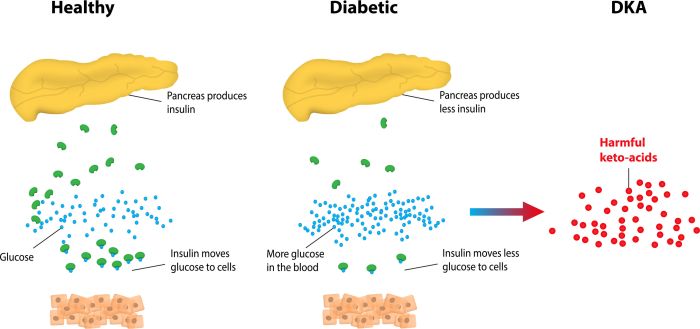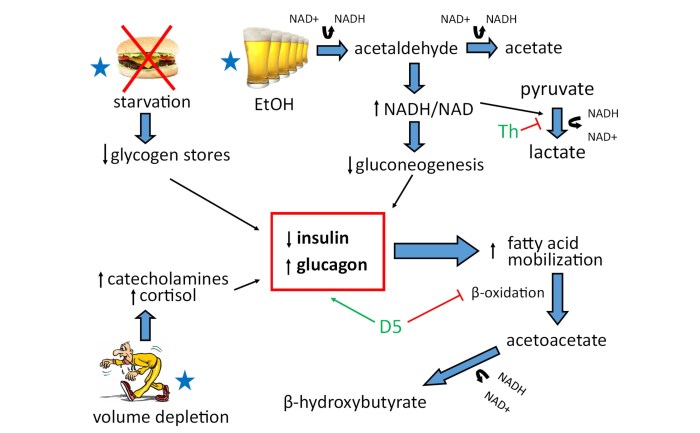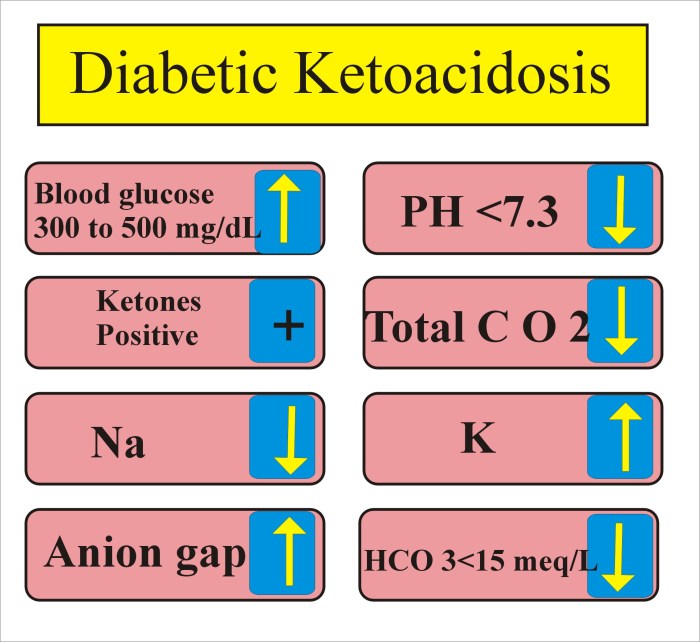A complication of diabetes mellitus where fats are improperly burned – Diabetic ketoacidosis (DKA) is a serious complication of diabetes mellitus that occurs when the body is unable to properly use glucose for energy, leading to the breakdown of fats and the production of ketones. This condition can be life-threatening if not treated promptly.
The symptoms of DKA can include excessive thirst, frequent urination, nausea, vomiting, abdominal pain, confusion, and loss of consciousness. The diagnosis of DKA is based on a combination of symptoms, blood tests, and urine tests. Treatment involves intravenous fluids, insulin, and electrolytes.
Pathophysiology of Diabetic Ketoacidosis (DKA)

DKA is a complication of diabetes mellitus characterized by the improper breakdown of fats, leading to the production of ketone bodies. The metabolic pathways involved in DKA include:
- Deficiency of insulin:Insulin is a hormone that promotes glucose uptake by cells. In DKA, insulin deficiency results in decreased glucose utilization and increased glucose production by the liver.
- Excess of glucagon:Glucagon is a hormone that stimulates glucose production by the liver. In DKA, elevated glucagon levels contribute to increased glucose production.
- Increased lipolysis:Insulin deficiency and glucagon excess promote lipolysis, the breakdown of fat into fatty acids. Fatty acids are then converted into ketone bodies by the liver.
Excessive ketone body production leads to:
- Metabolic acidosis:Ketone bodies are acidic and accumulate in the blood, causing a decrease in blood pH.
- Dehydration:Ketone bodies cause osmotic diuresis, leading to excessive urination and dehydration.
- Electrolyte imbalances:Ketone bodies bind to sodium and potassium ions, leading to electrolyte imbalances such as hyperkalemia and hypokalemia.
Clinical Manifestations of DKA
The classic triad of symptoms associated with DKA is:
- Polyuria:Excessive urination
- Polydipsia:Increased thirst
- Polyphagia:Increased hunger
Other signs and symptoms include:
- Dehydration:Dry skin and mucous membranes, decreased skin turgor, sunken eyes
- Electrolyte imbalances:Muscle cramps, weakness, fatigue
- Ketoacidosis:Kussmaul breathing (deep, rapid breathing), fruity breath odor, nausea, vomiting
- Altered mental status:Confusion, drowsiness, coma
Diagnostic Criteria for DKA

The biochemical parameters used to diagnose DKA include:
- Blood glucose:Typically >250 mg/dL
- Ketones:Urine or blood ketones present in large amounts
- pH:<7.3
Arterial blood gas analysis may be used to confirm DKA by measuring:
- pH:<7.3
- Bicarbonate:<15 mEq/L
- Anion gap:>10 mEq/L
Management of DKA
The treatment of DKA involves:
- Fluid resuscitation:Intravenous fluids are administered to correct dehydration.
- Insulin therapy:Insulin is administered intravenously to lower blood glucose levels.
- Electrolyte replacement:Electrolytes such as potassium and sodium are replaced intravenously.
Monitoring parameters include:
- Blood glucose:Monitored hourly
- Ketones:Monitored every 2-4 hours
- Electrolytes:Monitored every 4-6 hours
- Mental status:Monitored continuously
Complications associated with DKA management include:
- Hypoglycemia:Over-correction of blood glucose levels
- Hypokalemia:Excessive potassium loss
- Cerebral edema:Fluid shifts into the brain
Prevention of DKA: A Complication Of Diabetes Mellitus Where Fats Are Improperly Burned

Risk factors for developing DKA include:
- Poor glycemic control:Uncontrolled blood glucose levels
- Infection:Infections can increase insulin resistance and glucose production
- Stress:Emotional or physical stress can trigger DKA
- Missed insulin doses:Not taking insulin as prescribed
Prevention of DKA involves:
- Patient education:Patients should be educated about the signs and symptoms of DKA and how to prevent it.
- Self-management:Patients should monitor their blood glucose levels regularly and take insulin as prescribed.
- Regular medical checkups:Patients should see their healthcare provider regularly to assess glycemic control and identify any potential risk factors.
FAQ Guide
What is diabetic ketoacidosis (DKA)?
DKA is a serious complication of diabetes mellitus that occurs when the body is unable to properly use glucose for energy, leading to the breakdown of fats and the production of ketones.
What are the symptoms of DKA?
The symptoms of DKA can include excessive thirst, frequent urination, nausea, vomiting, abdominal pain, confusion, and loss of consciousness.
How is DKA diagnosed?
The diagnosis of DKA is based on a combination of symptoms, blood tests, and urine tests.
How is DKA treated?
Treatment involves intravenous fluids, insulin, and electrolytes.